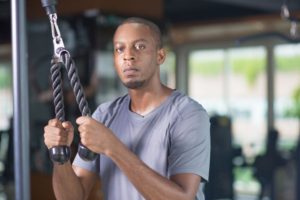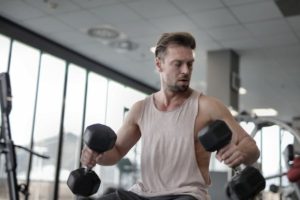We work out our muscles to look physically fit. In addition, properly nurturing the right muscles helps improve individual strength while providing excellent and good posture.

Face pulls and rear delt flyes are gym routines that help work out the upper back and shoulders muscles.
They are the best exercise for people wanting a more muscular, defined back. But how do these two muscle exercises compare?
This article will guide starters and those visiting the gym for a while. We cover all you need to know about face pulls and rear delt flyes.
Also, we discuss how you can use both or either to get your desired results.
Face Pulls vs. Rear Delt Flyes: An Overview
Face Pull is a gym routine that involves pulling two ropes hanging from the sides of a cable machine.
The face pull grows the upper back muscles (Rhomboids, Trapezius) and shoulders (Rotator Cuff muscles, Deltoid muscles).
It has a maximum effect on the deltoids and the rotator cuff muscles. It provides you with desired broad shoulders, thus enhancing your physique and posture.
Face pulls can be done in several forms depending on the target muscle. It is an exercise with a wide range of methods.
The equipment is also quite prevalent and can be found in any standard gym.
On the other hand, Rear Delt Flyes is another gym routine that involves standing erect with two dumbbells on both sides while drawing them toward the body’s midline.
The Rear Delt Fly also works on the upper back muscles but mainly focuses on the deltoid muscles of the shoulders in isolation.
Rear Delt Fly provides you with an accurate rounded contour of the shoulder. This includes shoulder stability and shoulder development, and improved functional strength.
Execution Technique
Face Pulls: To perform face pulls, attach a rope or band to a cable machine at about shoulder height. Stand facing the machine and grab the rope with an overhand grip.
Begin by retracting your shoulder blades and pulling the rope towards your face, ensuring your elbows are higher than your wrists at the end of the movement.
Focus on squeezing your rear delts and upper back throughout the exercise.
Rear Delt Flyes: For rear delt flyes, sit or stand with dumbbells in each hand, palms facing each other.
Keep your back straight and a slight bend in your knees. Bend forward at the hips, maintaining a neutral spine.
Lift your arms out to the sides, leading with your elbows, until they are parallel to the floor. Squeeze your shoulder blades together and focus on engaging the rear deltoids.

Muscle Activation
Face Pulls: Face pulls primarily target the rear deltoids, but they also engage the upper back muscles, including the rhomboids, traps, and rotator cuff muscles.
The exercise also activates the muscles responsible for scapular retraction and external rotation, promoting better posture and shoulder stability.
Rear Delt Flyes: Rear delt flyes isolate the rear deltoids more specifically.
They also recruit the upper back muscles, such as the rhomboids and traps, but to a lesser extent than face pulls.
The exercise helps develop the rear deltoids’ strength and size, contributing to a well-rounded shoulder appearance.
Joint Stress and Range of Motion
Face Pulls: Face pulls are relatively joint-friendly as they involve controlled movements with moderate stress on the shoulder joint.
The exercise allows for a greater range of motion, particularly when performed with the correct form.
However, individuals with pre-existing shoulder issues should exercise caution and consult a professional before adding face pulls to their routine.
Rear Delt Flyes: Rear delt flyes also put moderate stress on the shoulder joint, but the range of motion is generally more limited than face pulls.
The bent-over position in rear delt flyes may pose challenges for individuals with lower back issues.
It’s important to maintain proper form and avoid excessive weight to prevent joint strain.
Equipment and Accessibility
Face Pulls: Face pulls typically require access to a cable machine or resistance bands.
Cable machines are commonly available in most gym settings, making face pulls easily accessible.
Resistance bands offer a portable alternative for those exercising at home or on the go.
Rear Delt Flys: Rear delt flyes can be performed with dumbbells, cable machines, or resistance bands.
Dumbbells are widely available and suitable for home workouts or gym settings.
Cable machines provide a more controlled resistance, while resistance bands offer versatility and convenience.
Exercise Variations and Progression
Face Pulls: Face pulls offer various options for progression, such as adjusting the weight, altering the grip width, or incorporating different attachments.
Variations like high-face or band-face pulls can be introduced to further challenge the muscles or accommodate individual preferences.
Rear Delt Flys: Rear delt flyes can be modified by changing the angle of the bench or using different equipment like cables or resistance bands.

By increasing the weight, repetitions, or incorporating isometric holds, you can progressively challenge the rear deltoids.
Training Objectives and Muscle Balance
Face Pulls: Face pulls are beneficial for developing the rear deltoids and contribute to overall muscle balance and postural correction.
Since face pulls target the upper back muscles, including the rhomboids and traps, they help counteract the effects of the excessive chest and front shoulder training.
This promotes better posture, reduces the risk of imbalances, and enhances overall shoulder health.
Rear Delt Flys: Rear delt flyes primarily focus on isolating the rear deltoids, making them an ideal exercise for individuals looking to specifically target and strengthen this muscle group.
You can achieve a well-rounded and aesthetic shoulder appearance by prioritizing rear deltoid development.
Injury Prevention and Rehabilitation
Face Pulls: Face pulls can be particularly beneficial for individuals with shoulder issues or those recovering from injuries.
The exercise helps improve scapular stability, strengthens the rotator cuff muscles, and enhances the mind-muscle connection in the upper back region.
Incorporating face pulls into a rehabilitation or pre-rehabilitation program can aid in shoulder injury prevention and recovery.
Rear Delt Flys: When performed with proper form and appropriate resistance, Rear delt flyes can also contribute to shoulder stability and injury prevention.
By strengthening the rear deltoids, individuals can improve shoulder joint alignment and reduce the risk of imbalances that may lead to injury.
Remember, the effectiveness of any exercise ultimately depends on proper form, adequate resistance, and progressive overload.
It is recommended to consult with a qualified fitness professional to ensure proper execution, especially if you are new to these exercises or have specific concerns or limitations.
Factors to Consider When Deciding between Face Pulls and Rear Delt Fly
- Targeted Muscles: Both the face pull and rear delt fly focus on the upper back and shoulders muscles. Knowing which muscle you want to grow helps you choose an adequate routine.
- Availability of equipment: The available equipment will significantly determine your exercise. If the equipment of a particular routine is unavailable, you can take on the other training while combining it with different activities to get your desired result.
- Joint Safety: If one has sustained any injury before, it is better to go with a mild routine than a strenuous one. In this case, the Face pull is more favorable than the Rear Delt fly. The intensity of the face pull can also be controlled to a comfortable level.
Conclusion
The face pulls, and rear delt fly are similar in so many ways but still possess apparent, distinct features.
Both face pulls, and rear delt flyes are valuable exercises for targeting the rear deltoids and strengthening the upper back muscles.
Identifying what you need to achieve when stepping into the gym will help you choose the proper exercise for you.
They are both great exercises for working out the upper back and shoulder muscles, improving and stabilizing the shoulder joints while enhancing looks.

Some people collect expensive old cars, and I’m into collecting bikes. I have 15 different bikes: special mountain bikes, sportbikes, professional, amateur, and city bikes. My friends and colleagues call me a ‘bike expert’ because I give advice on how to choose the right bike.
I’m also a massive fan of gym culture and heavyweight workouts. I met Alan at my local gym, and we’ve become friends quite soon. His idea of starting a sports blog seemed interesting to me, so I agreed to help.





